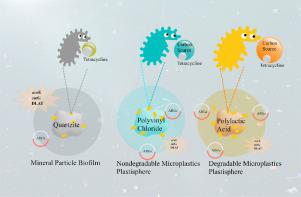Water Research ( IF 12.8 ) Pub Date : 2022-08-02 , DOI: 10.1016/j.watres.2022.118920 Jiao Wang 1 , Chu Peng 2 , Yexin Dai 1 , Yang Li 1 , Shipu Jiao 1 , Xiaodong Ma 3 , Xianhua Liu 1 , Lei Wang 2

|
Microplastics (MPs) are increasingly entering the urban aquatic ecosystems, and the environmental significance and health risks of plastisphere, a special biofilm on MPs, have received widespread attention. In this study, MPs of polylactic acid (PLA) and polyvinyl chloride (PVC) and quartzite were incubated in an urban water environment, and the tetracycline (TC) degradation ability was compared. Approximatedly 24% of TC biodegraded in 28 d in the water-quartzite system, which is significantly higher than that in the water-PLA (17.3%) and water-PVC systems (16.7%). Re-incubation of microorganisms in biofilms affirmed that quartzite biofilm has a higher TC degradation capacity than the plastisphere. According to high-throughput sequencing of 16S rRNA and metagenomic analysis, quartzite biofilm contained more abundant potential TC degrading bacteria, genes related to TC degradation (eutG, aceE, and DLAT), and metabolic pathways related to TC degradation. An oligotrophic environment on the quartzite surface might lead to the higher metabolic capacity of quartzite biofilm for unconventional carbons, e.g., TC. It is also found that, compared with quartzite biofilm, the distinct microbes in the plastisphere carried more antibiotic resistance genes (ARGs). Higher affinity of MPs surface to antibiotics may lead to higher antibiotics stress on the plastisphere, which further amplify the carrying capacity for ARGs of microorganisms in the plastisphere. Compared to the nondegradable PVC MPs, surface of the biodegradable PLA plastics harbored significantly higher amounts of biomass and ARGs. Compared to the mineral particles, the capability of plastisphere has lower ability to degrade unconventional carbon sources such as the refractory organic pollutants, due to the abundance of carbon sources (adsorbed organic carbon and endogenous organic carbon) on the MPs surface. Meanwhile, the stronger adsorption capacity for pollutants also leads to higher pollutant stress (such as antibiotic stress) in plastisphere, which in turn affects the microbiological characteristics of the plastisphere itself, such as carrying more ARGs.
中文翻译:

塑料球中抗生素降解较慢和抗性基因富集较高
微塑料(MPs)越来越多地进入城市水生生态系统,塑料球作为一种特殊的生物膜,其环境意义和健康风险受到广泛关注。本研究将聚乳酸 (PLA) 和聚氯乙烯 (PVC) 的 MPs 和石英岩在城市水环境中培养,比较了四环素 (TC) 的降解能力。水-石英石体系中约24%的TC在28 d内被生物降解,显着高于水-PLA(17.3%)和水-PVC系统(16.7%)。生物膜中微生物的重新培养证实了石英岩生物膜比塑料球具有更高的 TC 降解能力。根据 16S rRNA 高通量测序和宏基因组分析,石英岩生物膜中含有更丰富的潜在 TC 降解菌,eut G,王牌E 和 DLAT),以及与 TC 降解相关的代谢途径。石英岩表面的贫营养环境可能导致石英岩生物膜对非常规碳(例如TC)的更高代谢能力。还发现,与石英岩生物膜相比,塑料球中不同的微生物携带更多的抗生素抗性基因(ARGs)。MPs 表面对抗生素的更高亲和力可能导致对塑料球的更高抗生素压力,这进一步放大了塑料球中微生物对 ARGs 的承载能力。与不可降解的 PVC MPs 相比,可生物降解的 PLA 塑料表面含有显着更高量的生物质和 ARGs。与矿物颗粒相比,由于 MPs 表面存在大量碳源(吸附有机碳和内源有机碳),塑料球的降解能力较低,因此对难降解有机污染物等非常规碳源的降解能力较低。同时,对污染物更强的吸附能力也会导致塑料球内更高的污染物压力(如抗生素压力),进而影响塑料球本身的微生物特性,如携带更多的ARGs。


























 京公网安备 11010802027423号
京公网安备 11010802027423号